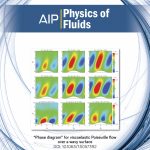Congratulations to Dr Simon Haward for his figure being selected as a cover image in Physics of Fluids.
Haward, S. J., Page, J., Zaki, T. A. & Shen, A. Q. 2018 “Phase diagram” for viscoelastic Poiseuille flow over a wavy surface. Phys. Fluids 30, 113101.
DOI: https://doi.org/10.1063/1.5057392
Congratulations to Dr Seo Yoon Jung for his figure being selected as a cover image in Journal of Fluid Mechanics.
Jung, S.Y. & Zaki, T. A. 2015 The effect of a low-viscosity near-wall film on bypass transition in boundary layers. J. Fluid Mech. 772, 330-360.
DOI: http://dx.doi.org/10.1017/jfm.2015.214
Journal Articles
Du, Yifan; Wang, Mengze; Zaki, Tamer A.
State estimation in minimal turbulent channel flow: A comparative study of 4DVar and PINN Journal Article
In: International Journal of Heat and Fluid Flow, vol. 99, pp. 109073, 2023, ISSN: 0142-727X.
Abstract | Links | BibTeX | Tags: 4DVar, Adjoint variational method, Data assimilation, Physics informed neural networks, PINN, State estimation, Turbulence
@article{du_etal_2023,
title = {State estimation in minimal turbulent channel flow: A comparative study of 4DVar and PINN},
author = {Yifan Du and Mengze Wang and Tamer A. Zaki},
url = {https://www.sciencedirect.com/science/article/pii/S0142727X22001412},
doi = {https://doi.org/10.1016/j.ijheatfluidflow.2022.109073},
issn = {0142-727X},
year = {2023},
date = {2023-01-01},
journal = {International Journal of Heat and Fluid Flow},
volume = {99},
pages = {109073},
abstract = {The state of turbulent, minimal-channel flow is estimated from spatio-temporal sparse observations of the velocity, using both a physics-informed neural network (PINN) and adjoint-variational data assimilation (4DVar). The performance of PINN is assessed against the benchmark results from 4DVar. The PINN is efficient to implement, takes advantage of automatic differentiation to evaluate the governing equations, and does not require the development of an adjoint model. In addition, the flow evolution is expressed in terms of the network parameters which have a far smaller dimension than the predicted trajectory in state space or even just the initial condition of the flow. Provided adequate observations, network architecture and training, the PINN can yield satisfactory estimates of the flow field, both for the missing velocity data and the entirely unobserved pressure field. However, accuracy depends on the network architecture, and the dependence is not known a priori. In comparison to 4DVar estimation which becomes progressively more accurate over the observation horizon, the PINN predictions are generally less accurate and maintain the same level of errors throughout the assimilation time window. Another notable distinction is the capacity to accurately forecast the flow evolution: while the 4DVar prediction depart from the true flow state gradually and according to the Lyapunov exponent, the PINN is entirely inaccurate immediately beyond the training time horizon unless re-trained. Most importantly, while 4DVar satisfies the discrete form of the governing equations point-wise to machine precision, in PINN the equations are only satisfied in an L2 sense.},
keywords = {4DVar, Adjoint variational method, Data assimilation, Physics informed neural networks, PINN, State estimation, Turbulence},
pubstate = {published},
tppubtype = {article}
}
Leoni, Patricio Clark Di; Agarwal, Karuna; Zaki, Tamer A.; Meneveau, Charles; Katz, Joseph
Reconstructing turbulent velocity and pressure fields from under-resolved noisy particle tracks using physics-informed neural networks Journal Article
In: Experiments in Fluids, vol. 64, no. 5, pp. 95, 2023, ISBN: 1432-1114.
Abstract | Links | BibTeX | Tags: Data assimilation, Machine Learning, PINN
@article{clarkdileoni_etal_2023bb,
title = {Reconstructing turbulent velocity and pressure fields from under-resolved noisy particle tracks using physics-informed neural networks},
author = {Patricio Clark Di Leoni and Karuna Agarwal and Tamer A. Zaki and Charles Meneveau and Joseph Katz},
url = {https://doi.org/10.1007/s00348-023-03629-4},
doi = {10.1007/s00348-023-03629-4},
isbn = {1432-1114},
year = {2023},
date = {2023-01-01},
journal = {Experiments in Fluids},
volume = {64},
number = {5},
pages = {95},
abstract = {Volume-resolving imaging techniques are rapidly advancing progress in experimental fluid mechanics. However, reconstructing the full and structured Eulerian velocity and pressure fields from under-resolved and noisy particle tracks obtained experimentally remains a significant challenge. We adopt and characterize a method based on Physics-Informed Neural Networks (PINNs). In this approach, the network is regularized by the Navier–Stokes equations to interpolate the velocity data and simultaneously determine the pressure field. We compare this approach to the state-of-the-art Constrained Cost Minimization method Agarwal et al. (2021). Using data from direct numerical simulations and various types of synthetically generated particle tracks, we show that PINNs are able to accurately reconstruct both velocity and pressure even in regions with low particle density and small accelerations. We analyze both the root-mean-square error of the reconstructions as well their energy spectra. PINNs are also robust against increasing the distance between particles and the noise in the measurements, when studied under synthetic and experimental conditions. Both the synthetic and experimental datasets used correspond to moderate Reynolds number flows.},
keywords = {Data assimilation, Machine Learning, PINN},
pubstate = {published},
tppubtype = {article}
}


